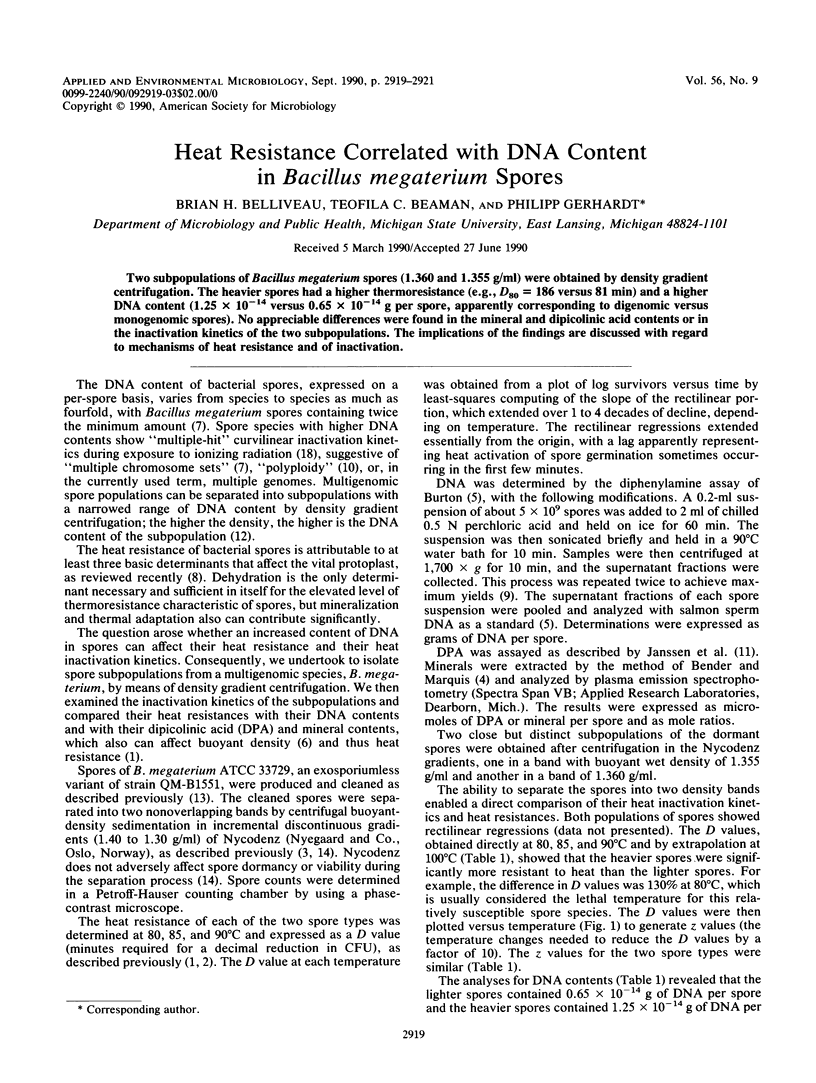Abstract
Two subpopulations of Bacillus megaterium spores (1.360 and 1.355 g/ml) were obtained by density gradient centrifugation. The heavier spores had a higher thermoresistance (e.g., D80 = 186 versus 81 min) and a higher DNA content (1.25 × 10−14 versus 0.65 × 10−14 g per spore, apparently corresponding to digenomic versus monogenomic spores). No appreciable differences were found in the mineral and dipicolinic acid contents or in the inactivation kinetics of the two subpopulations. The implications of the findings are discussed with regard to mechanisms of heat resistance and of inactivation.
Full text
PDF


Selected References
These references are in PubMed. This may not be the complete list of references from this article.
- Beaman T. C., Gerhardt P. Heat resistance of bacterial spores correlated with protoplast dehydration, mineralization, and thermal adaptation. Appl Environ Microbiol. 1986 Dec;52(6):1242–1246. doi: 10.1128/aem.52.6.1242-1246.1986. [DOI] [PMC free article] [PubMed] [Google Scholar]
- Beaman T. C., Greenamyre J. T., Corner T. R., Pankratz H. S., Gerhardt P. Bacterial spore heat resistance correlated with water content, wet density, and protoplast/sporoplast volume ratio. J Bacteriol. 1982 May;150(2):870–877. doi: 10.1128/jb.150.2.870-877.1982. [DOI] [PMC free article] [PubMed] [Google Scholar]
- Beaman T. C., Pankratz H. S., Gerhardt P. Heat shock affects permeability and resistance of Bacillus stearothermophilus spores. Appl Environ Microbiol. 1988 Oct;54(10):2515–2520. doi: 10.1128/aem.54.10.2515-2520.1988. [DOI] [PMC free article] [PubMed] [Google Scholar]
- Bender G. R., Marquis R. E. Spore heat resistance and specific mineralization. Appl Environ Microbiol. 1985 Dec;50(6):1414–1421. doi: 10.1128/aem.50.6.1414-1421.1985. [DOI] [PMC free article] [PubMed] [Google Scholar]
- Dean D. H., Douthit H. A. Buoyant density heterogeneity in spores of Bacillus subtilis: biochemical and physiological basis. J Bacteriol. 1974 Feb;117(2):601–610. doi: 10.1128/jb.117.2.601-610.1974. [DOI] [PMC free article] [PubMed] [Google Scholar]
- FITZ-JAMES P. C., YOUNG I. E. Comparison of species and yarieties of the genus Bacillus. Structure and nucleic acid content of spores. J Bacteriol. 1959 Dec;78:743–754. doi: 10.1128/jb.78.6.743-754.1959. [DOI] [PMC free article] [PubMed] [Google Scholar]
- Hitchins A. D. Polarity and topology of DNA segregation and septation in cells and sporangia of the bacilli. Can J Microbiol. 1978 Oct;24(10):1104–1134. [PubMed] [Google Scholar]
- JANSSEN F. W., LUND A. J., ANDERSON L. E. Colorimetric assay for dipicolinic acid in bacterial spores. Science. 1958 Jan 3;127(3288):26–27. doi: 10.1126/science.127.3288.26. [DOI] [PubMed] [Google Scholar]
- Johnston G. C., Young I. E. Variability of DNA content in individual cells of Bacillus. Nat New Biol. 1972 Aug 9;238(84):164–166. doi: 10.1038/newbio238164a0. [DOI] [PubMed] [Google Scholar]
- Koshikawa T., Beaman T. C., Pankratz H. S., Nakashio S., Corner T. R., Gerhardt P. Resistance, germination, and permeability correlates of Bacillus megaterium spores successively divested of integument layers. J Bacteriol. 1984 Aug;159(2):624–632. doi: 10.1128/jb.159.2.624-632.1984. [DOI] [PMC free article] [PubMed] [Google Scholar]
- Lindsay J. A., Beaman T. C., Gerhardt P. Protoplast water content of bacterial spores determined by buoyant density sedimentation. J Bacteriol. 1985 Aug;163(2):735–737. doi: 10.1128/jb.163.2.735-737.1985. [DOI] [PMC free article] [PubMed] [Google Scholar]
- WOESE C. R. Comparison of the x-ray sensitivity of bacterial spores. J Bacteriol. 1958 Jan;75(1):5–8. doi: 10.1128/jb.75.1.5-8.1958. [DOI] [PMC free article] [PubMed] [Google Scholar]


